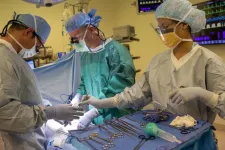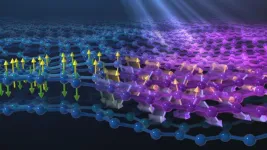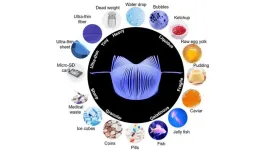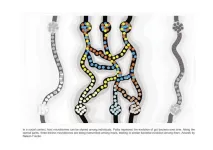(Press-News.org) UCLA-led research describes the role that a protein called CEACAM1 plays in protecting the liver from injury during the transplantation process, potentially improving transplant outcomes. But the features that regulate this protective characteristic remain unknown.
In a new study, to be published online Aug. 2 in Science Translational Medicine, a research team has identified the molecular factors at the root of this protection and shown how using molecular tools and alternative gene splicing can make CEACAM1 more protective, thus reducing organ injury and ultimately improving post-transplant outcomes.
Prior to transplantation, a solid organ, such as a liver, has no blood flow and, as a result, lacks oxygen. Blood supply is returned to the organ during transplantation, but that process can cause inflammation and tissue damage called ischemic reperfusion injury, also known as reoxygenation injury.
“Understanding the factors that lead to organ shortage remains the best option to expand the donor pool available for life-saving transplantation,” said Kenneth Dery, an associate project scientist in the UCLA Department of Surgery and the study’s lead author. “Peri-transplant events, such as ischemia-reperfusion injury activate the recipient’s immune responses and negatively affect outcomes.
Specifically, the researchers found that Hypoxia Inducible Factor 1 (HIF-1α), which regulates oxygen consumption, played a central role in orchestrating the activation of the version of CEACAM1, called CEACAM1-S, that limits cellular injury and improves liver function in mice. They also found that this relationship between CEACAM1-S and HIF-1 in donor livers in humans predicts better overall liver transplantation outcomes and better immune functioning.
The researchers identified a novel gene expression pathway that becomes activated following ischemia and oxygen stress. This pathway, called alternative splicing, is an adaptation that cells use to boost their protein diversity in times of danger, inflammation, and injury. The researchers showed that as the cell senses low oxygen conditions, HIF-1α begins regulating the RNA splicing factor, Polypyrimidine tract-binding protein 1 (Ptbp1), that in turn directs the splicing of the CEACAM1 gene, leading to the protective CEACAM1-S version that reduces the liver injury that accompanies transplantation.
In addition, the researchers used a molecule called DMOG in animal studies to stabilize HIF-1α in vivo, under normal oxygen conditions, which effectively boosted the protective version of CEACAM1-S, thus providing a therapeutic proof-in-concept for future studies.
“These results suggest that CEACAM1-S may be a potential marker of liver quality and that efforts to increase its expression may have therapeutic benefits for transplantation or acute liver injury,” the researchers write.
The next steps will be to test the perfusion of tissues from suboptimal human livers that were kept in extended cold storage in the presence of molecules called morpholinos that modify gene expression.
Many hundred genes are likely undergoing alternative splicing in an effort to manage the cellular stress that accompanies liver transplanation, Dery said.
“Our hypothesis is that if we can identify all the alternative splicing changes that are occuring following ischemic stress, we can begin to really understand how to “rejuvenate” donor organs, which play an important role in reducing organ shortages,” he said. “Forming the ‘beneficial’ version of CEACAM1-S prior to liver transplantation has the potential to act as a checkpoint regulator of oxygen-related stress and will see a reduction of liver ischemia-reperfusion injury.”
Study co-authors are Dr. Hidenobu Kojima, Dr. Shoichi Kageyama, Dr. Kentaro Kadono, Dr. Hirofumi Hirao, Brian Cheng, Dr. Yuan Zhai, Dr. Douglas Farmer, Dr. Fady Kaldas, and Dr. Jerzy Kupiec-Weglinski of UCLA; and Xiaoyi Yuan and Dr Holger Eltzschig of UT Health. Kageyama and Kadono are now at Kyoto University and Zhai is currently at the University of South Carolina.
The study was funded by grants from the National Institutes of Health (P01 AI120944, R01 DK062357, DK107533, DK102110, R01HL154720, R01DK122796, R01HL133900, and R01HL155950); the Department of Defense (W81XWH2110032); a Parker B. Francis Fellowship, and an American Lung Association Catalyst Award (CA-622265).
END
Researchers discover a novel pathway that minimizes liver injury during transplantation
2023-08-02
ELSE PRESS RELEASES FROM THIS DATE:
UIC leads field study on home, water safety after Ohio chemical spill
2023-08-02
In February, the train derailment and subsequent chemical spill and fires in East Palestine, Ohio, caused an environmental emergency that led thousands of people to evacuate their homes. A multi-university study led by the University of Illinois Chicago will investigate the aftermath of that disaster, collecting data on the experiences of nearby residents and the effectiveness of communication from authorities about water, soil and air quality.
For the study, the researchers will conduct surveys and interviews with residents in and near East Palestine, including counties ...
MD Anderson research highlights for August 2, 2023
2023-08-02
HOUSTON ― The University of Texas MD Anderson Cancer Center’s Research Highlights showcases the latest breakthroughs in cancer care, research and prevention. These advances are made possible through seamless collaboration between MD Anderson’s world-leading clinicians and scientists, bringing discoveries from the lab to the clinic and back.
Recent developments include a novel biomarker that may predict the aggressiveness of pancreatic cancer precursors, insights into the structure and function of a breast and ovarian cancer susceptibility gene, a new approach to overcoming treatment resistance in ovarian cancer, distinguishing features of young-onset ...
August issues of American Psychiatric Association journals cover alcohol use disorder, interventions for PTSD and psychedelics in psychiatry
2023-08-02
The latest issues of three of the American Psychiatric Association’s journals, The American Journal of Psychiatry, Psychiatric Services and Focus are now available online.
The August issue of The American Journal of Psychiatry on the neurodevelopmental origins of psychopathology is focused on early-life adversity and genetics as mediators of the risk to develop psychiatric illnesses. Highlights include:
Overview of Alcohol Use Disorder.
A Comprehensive Multilevel Analysis of the Bucharest Early Intervention Project: Causal Effects on Recovery from Early Severe Deprivation. ...
Eyewitnesses to Arctic Change
2023-08-02
On Thursday, 3 August 2023, the research vessel Polarstern is scheduled to set off from Tromsø, Norway, towards the North Pole. For two months, a good fifty scientific expedition participants will explore the Arctic in transition as sea ice extent reaches its annual minimum in September. They will explore the biology, chemistry and physics of sea ice as well as the effects of sea ice retreat on the entire ocean system from the surface to the deep sea. Eleven years ago, Antje Boetius was part of the largest ever sea ice minumum in the Arctic ...
New neuroimaging approach could improve diagnosis of schizophrenia
2023-08-02
ATLANTA — New research led by scientists working with Georgia State University’s TReNDS Center has identified age-related changes in brain patterns associated with the risk for developing schizophrenia.
The discovery could help clinicians identify the risk for developing mental illness earlier and improve treatment options. The study is published in the Proceedings of the National Academy of Sciences (PNAS).
The research is part of a collaboration by experts from the University of Bari Aldo Moro, the Lieber Institute of Brain Development and the Tri-institutional Center for Translational Research in ...
Scientists discover unusual ultrafast motion in layered magnetic materials
2023-08-02
A common metal paper clip will stick to a magnet. Scientists classify such iron-containing materials as ferromagnets. A little over a century ago, physicists Albert Einstein and Wander de Haas reported a surprising effect with a ferromagnet. If you suspend an iron cylinder from a wire and expose it to a magnetic field, it will start rotating if you simply reverse the direction of the magnetic field.
“Einstein and de Haas’s experiment is almost like a magic show,” said Haidan Wen, a ...
New review calls on Hockey Canada to raise age of body contact from 13 to 15
2023-08-02
Hockey leagues in Canada should overhaul current rules and regulations to raise the age of bodychecking in the game from 13 to 15, says new research into the effect of body contact on teens.
The literature review was led by Dr. Kristian Gouletnorth_eastexternal link of the University of Ottawa’s Faculty of Medicine and Children’s Hospital of Eastern Ontario (CHEO) and calls on provincial and territorial governments to mandate schools – including those involved with school sports – and sports organizations to establish, ...
Robotic grippers offer unprecedented combo of strength and delicacy
2023-08-02
Researchers at North Carolina State University have developed a robotic gripping device that is gentle enough to pick up a drop of water, strong enough to pick up a 6.4 kilogram (14.1 pound) weight, dexterous enough to fold a cloth, and precise enough to pick up microfilms that are 20 times thinner than a human hair. In addition to possible manufacturing applications, the researchers also integrated the device with technology that allows the gripper to be controlled by the electrical signals produced by muscles in the forearm, demonstrating its potential for use with robotic prosthetics.
“It is difficult ...
The Power of host social interactions in bacterial evolution
2023-08-02
Previous studies in humans and animals showed that hosts in a social condition (sharing the same space) harbor a more similar microbiota composition. Microbial transmission between hosts, which is increased when living in the same household, leads to similar species inhabiting the gut. However, whether bacterial evolution in the gut is affected by microbiota transmission remained unknown.
To fill this knowledge gap, the researchers used an innovative in vivo experimental evolution approach, which revealed an average transmission rate ...
Waves of charge signal rare physics at work inside a superconductor
2023-08-02
‘A place for everything and everything in its place’–making sense of order, or disorder, helps us understand nature. Animals tend to fit nicely into categories: Mammals, birds, reptiles, whatever an axolotl is, and more. Sorting also applies to materials: Insulator, semiconductor, conductor, and even superconductor. Where exactly a material lands in the hierarchy depends on a seemingly invisible interplay of electrons, atoms, and their surroundings.
Unlike animals, the boundaries are less sharp, and tweaking a material’s ...






